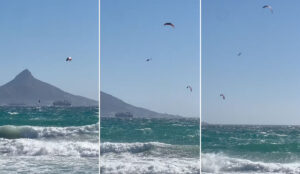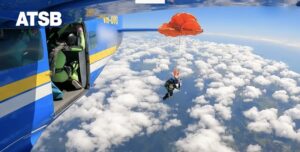Brown bears mauled and ate three people after a helicopter crash on a luxury tour in the far northeastern reaches of Russia.
In the July 16 incident in Kamchatka, helicopter pilot and Russian biathlete Igor Malinovsky, 25, perished along with his two passengers, Zoya Kaigorodova and Sergey Kolesnyak.
Russian officials found the remains of the three individuals near the Semyachkov Pass, 13km from the Uzon volcano, the following day. Brown bears appeared to have found their bodies at the crash site, dragged them away, and fed on them.

Zoya Kaygorodova (left) and Igor Malinovsky (right, in helicopter). Photos: social networks/e2w, Igor Malinovsky/e2w
The Ministry of Emergency Situations reported the crash, per Russia’s Channel Five news. It occurred in poor flying conditions during a nine-day tour of the region.
The route they took on the day of the incident centered around the Uzon caldera, in the heart of Kamchatka’s volcanic region. By 7 pm local time, their Robinson helicopter was supposed to land in the nearby village of Milkovo. But communication with the ship dropped off, triggering a search.

Robinson R-44 helicopter. Photo: Meoita via Shutterstock
Did the bears kill or just scavenge?
The adverse weather, with reported dense clouds and low visibility, stopped search-and-rescue teams from starting work immediately. When the weather improved the next day, they found the burned-out helicopter.
It’s unclear whether the tourists were already deceased when the bears found them at the crash site. Generally, brown bears avoid attacking humans unless threatened in some way. And in the Kamchatka wilderness, food like berries and salmon are plentiful.
However, brown bears hunt and forage opportunistically and will readily scavenge. Kamchatka brown bears are among the world’s largest ursines and can grow to almost 700 kilograms. And they have killed people before. In a well-known older incident, celebrated Japanese wildlife photographer Michio Hochino died when a bear dragged him from his tent in southern Kamchatka in 1996.
Igor Malinovsky had become a helicopter pilot after retiring from his career as an athlete. His father, Vladimir Malinovsky, was the helicopter’s owner. Ukrainian media described Kaigorodova as a “well-known local businesswoman in her 30s”. Kolesknyak, 39, worked as the head of the Swedish mobile communications company Tele2.
The nine-day tour reportedly cost the equivalent of a little over $5,000. Officials have launched an investigation into the crash and the three deaths.

There are no roads in that part of Kamchatka, and the only way to access the spectacular volcanic scenery is by helicopter. Photo: Jerry Kobalenko
Initially, Vladimir Solodov, Governor of the Kamchatka Territory, said the group was traveling without tourist credentials and confirmed the investigation.
“The helicopter with two passengers and a pilot was on a private flight; the group was not registered as tourists,” Solodov said via his Telegram channel the day after the crash. “The competent authorities are conducting an investigation and will establish the reasons for the departure and the circumstances of the crash.”
Meanwhile, the Russian biathlon community expressed its mourning for Malinovsky. The young athlete reportedly struggled with injuries before terminating his promising career early.
“We are all very sorry. He was still a part of our men’s team for quite a long time, showing great promise. It is a pity first of all for a person, and secondly for an athlete. As far as I know, he hesitated whether to leave biathlon or not, to concentrate only on flying or not. The guy [was] still young,” Yuri Kaminsky, head coach of the Russian men’s national biathlon team, told sports outlet Match TV.
Emphasizing the current tension between Russia and the West, Russian media took pains to point out in its headline that the helicopter involved in the crash was American-made. Meanwhile, Ukrainian media, which also covered the incident, suggested that because of sanctions, the Russians couldn’t holiday in Europe, so they went instead to an exotic part of their own country, where they died.






